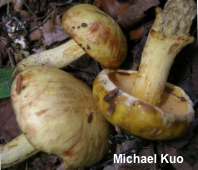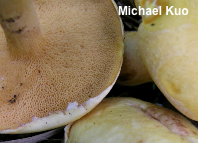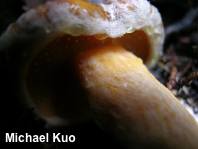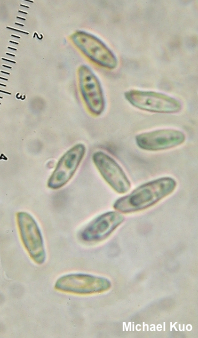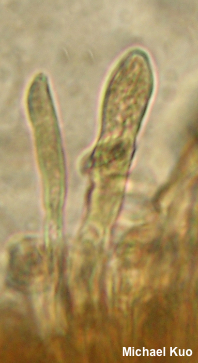| Major Groups > Boletes > Suillus > Suillus subaureus |

|
Suillus subaureus [ Basidiomycota > Boletales > Suillaceae > Suillus . . . ] by Michael Kuo Here is one species of Suillus that does not always associate with conifers; it is often found under oaks, quaking aspen, or big-toothed aspen, without any conifers in the vicinity. Salient physical features for Suillus subaureus include the orange pore surface; the yellow cap that develops red streaks and spots; the ringless stem that develops glandular dots with maturity, and the yellow flesh that stains reddish (especially in the stem base) when sliced. Most specimens manifest a "false veil" of soft, whitish tissue along the young cap edge. Snell & Dick (1970) theorized that fruitings of Suillus subaureus without conifers present were probably limited to areas "where white pines once grew." More recently, extensive experimentation by Lofgren and collaborators (2018) determined that Suillus subaureus is able to colonize pine, oak, and larch seedlings, suggesting that the mushroom is becoming a generalist and expanding its host capacity, rather than merely switching from white pines to hardwoods. Similar species include Suillus glandulosipes (AKA "Suillus albidipes" and neoalbidipes), which does not develop red discolorations and has a browner cap and a yellow young pore surface; Suillus americanus, which is limited to eastern white pine and features a ring on the stem; and, Suillus hirtellus, which is associated with southern hard pines (loblolly pine, shortleaf pine, and longleaf pine) and is not likely to overlap in range with Suillus subaureus except perhaps in the lower Appalachians. Suillus hirtellus features a darker yellow, more fibrillose cap, a yellow young pore surface, and flesh that does not stain reddish when sliced. Speaking of the similarities between Suillus subaureus and Suillus hirtellus, there is a very deep and foreboding rabbit hole that some intrepid mycologist will need to go down some day before we can be sure we are applying names correctly. I have only taken a peek down there from the safety of the outside, and from this vantage point we can clearly see the original author of both species, Peck (1887, 1889), compiling mixed type collections, changing his mind about his species, describing them inconsistently, and potentially confusing what individual specimens originally came from where (New York or North Carolina). I have been down a similar rabbit hole with Peck once before (see Morchella angusticeps), and it was not pretty. So if you're saying, "What, you mean the rabbit? I soiled my armor, I was so scared!" I'm telling you "that rabbit's got a vicious streak a mile wide; it's a killer!" Description: Ecology: Apparently mycorrhizal with oaks, quaking aspen and big-toothed aspen, as well as eastern white pine; growing alone, scattered, or gregariously in summer and fall; originally described from New York; distributed in the northern Midwest and northeastern North America. The illustrated and described collections are from Michigan. Cap: 3–12 cm; convex becoming broadly convex or nearly flat; sticky when fresh; bright to pale yellow or brownish yellow; often with scattered reddish, appressed fibrils, developing a reddish-spotted or streaked appearance; when young with a cottony to felty roll of marginal tissue that sometimes persists into maturity as an inrolled sterile margin. The cap stains waxed paper bright yellow. Pore Surface: Pale orange to orange when young; becoming brownish yellow and eventually brown; not bruising; often exuding droplets of yellowish liquid when young; pores angular and radially arranged by maturity, about 2 per mm across; tubes to 1 cm deep. Stem: 4–9 cm long; 1–1.5 cm thick; more or less equal; sticky when young; yellow to yellowish; glandular dots at first concolorous and inconspiuous but by maturity becoming cinnamon brown to nearly black; without a ring; basal mycelium white. Flesh: Yellowish orange to yellow; usually staining pinkish to reddish when sliced, especially in the stem base. Odor and Taste: Odor not distinctive; taste slightly acidic. Chemical Reactions: Ammonia on cap surface red to purplish red; on flesh red to reddish. KOH gray to reddish gray on cap surface; blue to purple on flesh. Iron salts negative or grayish on cap surface; grayish or green on flesh. Spore Print: Cinnamon brown. Microscopic Features: Spores 6–10 x 2.5–3.5 µm; boletoid-fusiform; smooth; hyaline in KOH; inamyloid. Basidia 22–26 x 4–5 µm; subclavate; 4-sterigmate. Cystidia in gelatinized, amber brown to brown bundles; often poorly defined individually; 40–60 x 4–9 µm; subfusiform, cylindric, or irregularly clavate; smooth; thin-walled; brown in KOH. Pileipellis an ixocutis; elements 2.5–7.5 µm wide, smooth, hyaline in KOH. REFERENCES: (C. H. Peck, 1887) W. H. Snell, 1944. (Peck, 1889; Coker & Beers, 1943; Smith & Thiers, 1964; Snell & Dick, 1970; Smith & Thiers, 1971; Grund & Harrison, 1976; Smith, Smith & Weber, 1981; Phillips, 1991/2005; Both, 1993; Bessette et al., 2000; Kuo & Methven, 2010; Klofac, 2013; Bessette et al., 2016; Nguyen et al., 2016; Lofgren et al., 2018; Sturgeon, 2018.) Herb. Kuo 09110407, 09120406, 09120704, 09120705. This site contains no information about the edibility or toxicity of mushrooms. |
© MushroomExpert.Com |
|
Cite this page as: Kuo, M. (2022, March). Suillus subaureus. Retrieved from the MushroomExpert.Com Web site: http://www.mushroomexpert.com/suillus_subaureus.html |
